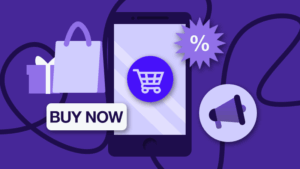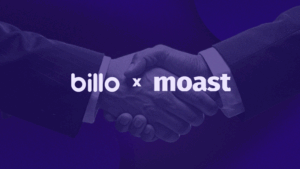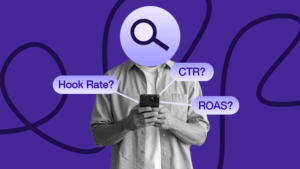Viral Power Plays: Ecommerce Content Marketing Examples & The Metrics Behind Them
Passionate content and search marketer aiming to bring great products front and center. When not hunched over my keyboard, you will find me in a city running a race, cycling or simply enjoying my life with a book in hand.

Ecommerce brands are playing a new game and content is how they’re winning.
With 80% of consumers now trusting the brands they already buy from more than media, business, or government, trust has become the biggest differentiator. Add to that the fact that content marketing delivers an average $7.65 return for every $1 spent, and it’s clear: the brands that master content don’t just capture attention – they convert it.
In this post, we’ll break down five ecommerce content marketing examples that didn’t just go viral, but drove real results. Each one offers a different angle for turning audience connection into sales growth. Let’s dive in!
TL;DR:
- Gymshark: #Gymshark66 challenge fueled 200M+ TikTok views and 4.3M+ followers
- Sephora: Always-on creator squad generated 6K+ posts, 200M+ reach annually
- Duolingo: Meme-led campaign hit 90M views, 1,400% follower growth in Brazil
- BlendJet: Gifted UGC drove $11.4K EMV with 2.99% engagement rate
- Liquid Death: Edgy content + purpose hit $263M retail and $1.4B valuation
Why Content Wins in Ecommerce Today
In today’s ecommerce landscape, content is more than marketing, it’s proof.
Brand trust is now as important to consumers as the price or product quality. According to the 2025 Edelman Trust Barometer, 80% of shoppers say trust directly influences what they buy and who they buy from.
That trust is built on social proof. People rely on people – 92% trust recommendations from their peers, and 70% trust online reviews more than ads, according to a 2025 social proof roundup by Adam Connell. UGC, testimonials, influencer content, they all help validate purchase decisions in a way no brand claim can.
And the payoff is clear. Weekly content publishers generate 3.5× more conversions than those posting monthly. And when done right, content marketing returns $7.65 for every $1 spent, based on 2025 data from SQ Magazine. It appears if you want to sell more in 2025, your content must do more than inform, it must create trust at scale.
Let’s break down five of the most compelling ecommerce content marketing examples from recent years. Each brand took a different route -challenges, creators, memes, or shock value, but all of them turned content into measurable conversion.
First up: how Gymshark built a movement, not just a moment.
1. Community-Driven Challenges (Gymshark)
Instead of simply joining the TikTok wave, Gymshark chose to shape it. Their #Gymshark66 challenge invited users to commit to 66 days of fitness, tapping into self-improvement culture with a mission-driven twist. The result? Over 200 million views on TikTok and a surge past 4.3 million followers by 2024.
@imaannaveed2001 #gymshark66 pledge: to be a better version of myself in 66 days 🍀💪🏼 The goals: 1. Daily 30 minute walk 2. Making my bed everyday 3. Stay in my 1600 calorie allowance @Gymshark @Gymshark Women #gymshark #gymshark66challenge #gymshark66pledge
♬ set fire to the rain x lovely – That Guy
But the real genius lies in what came next. Rather than treating it as a one-off stunt, Gymshark folded challenge-driven UGC into their ongoing product strategy. Every new drop gets bolstered by a ready-made army of creators already invested in the brand’s vision, and already creating content that performs.
This isn’t just virality, it’s a sustainable UGC engine built on purpose, not just promotion.
2. Always-On Influencer Programs (Sephora)
While most brands treat influencer marketing as a campaign toggle, Sephora turned it into an ecosystem. The Sephora Squad is a year-round creator collective that selects 24 influencers annually from over 10,000 applicants. These aren’t just pretty faces, they’re diverse voices trusted by niche audiences across platforms.
The results? Over 6,000 original posts each year, a collective reach of 200 million+, and members who see their Instagram followings grow by an average of 350%, according to Marketing Scoop.
@thatgirlwiththecurlyhair Such an insane day!!!! So grateful and feeling so fulfilled💕
♬ original sound – Joy Burnett
By investing in long-term creator relationships, Sephora trades transactional ads for authentic brand advocacy, the kind that compounds over time and delivers compounding returns. Sustainable influence is not limited to short-term reach. It’s about building a trusted creator community that grows with your brand.
3. Brand Mascots & Meme Culture (Duolingo)
Duolingo didn’t just go viral, they went full chaos mode, and it worked. The brand’s TikTok persona, led by its unhinged green owl mascot, redefined what B2C tone can be in the edtech space.
Take their “Speaking English Doesn’t Cost” campaign in Brazil: it generated 90 million video views, reached 38 million unique users, and delivered a 39% click-through rate above the education-sector benchmark. The campaign also fueled a 1,400% jump in followers, as detailed in this TikTok for Business case study.
By merging meme culture with meaningful messaging, Duolingo struck a rare balance – going viral while staying on-brand and driving real performance. Leaning into internet culture works when you have a strong brand POV and the data to prove it converts.
4. UGC-Powered Funnels (BlendJet)
BlendJet’s growth didn’t come from glossy campaigns. It came from gifted creators and smart repurposing. The brand launched a UGC pilot by seeding products to everyday creators, then measured what moved the needle.
In just three months, that test delivered 63,000 impressions, 8,000+ interactions, and a 2.99% engagement rate. Even better, it generated over $11.4K in earned media value (EMV), a result BlendJet then scaled by weaving top-performing content into paid ad funnels, according to a 2025 Skeepers case study.
It’s a playbook rooted in iteration: use organic UGC to surface what converts, then amplify with ad spend. When you treat UGC as performance fuel, even gifted content can become a scalable revenue channel.
5. Challenger Storytelling & Shock Value (Liquid Death)
Liquid Death built a cult following by breaking every rule of CPG branding. Their irreverent tone, punk visuals, and over-the-top campaigns like “Murder Your Thirst” turned canned water into a lifestyle statement.
But it wasn’t just noise. Their anti-plastic mission (“Death to Plastic”) grounded the theatrics in real impact, fueling both credibility and conversions. By 2023, the brand hit $263 million in retail sales and secured a $1.4 billion valuation by March 2024, according to Axios.
@liquiddeath Liquid Death Rootbeer Wrath sparkling water: It’s clear! // repost from @Afferdin // #Liquiddeath #murderyourthirst #deathtoplastic
♬ original sound – Liquid Death
Liquid Death shows how provocation can be a growth lever, when it’s built on values, not just vibes. Challenger brands win by taking risks, but the risk only works when it’s anchored in purpose.
Patterns Shared by Top Performers
Across wildly different strategies – challenges, creators, memes, and shock value, one theme ties these ecommerce winners together: trust through community.
The highest-performing brands don’t just post content. They invest in creator equity, build UGC systems, and let their customers lead the narrative. It’s a trust flywheel: creators attract attention, community builds belief, and social proof drives conversions.
And the stats back it up. According to Adam Connell’s 2025 report, 92% of shoppers rely on peer recommendations before purchase. That means the brands that elevate real voices, not just polished ads win both attention and sales.
Today’s content winners aren’t louder, they’re more trusted. Build community, scale creators, and let your customers speak.
Best Ecommerce Content Marketing Examples Summary
The best ecommerce content marketing examples don’t rely on big budgets. They rely on creator-driven trust, community momentum, and strategic content repurposing. Whether it’s Gymshark’s viral challenges, Sephora’s scalable influencer network, or Liquid Death’s unapologetic storytelling, each brand turns engagement into sales through smart, repeatable systems.
If you’re ready to do the same, start by investing in UGC that performs. Use it to build social proof, power ad funnels, and grow your audience with content that actually converts.
Need help scaling creator content that works? Browse Billo creators or check out our TikTok ad guide to start turning content into conversions.
FAQs
How many pieces of UGC do I need before running paid ads?
Start with 3–5 diverse UGC assets to test hooks, tones, and formats. From there, double down on what performs.
What KPIs best prove creator program ROI to finance teams?
Focus on Cost Per Acquisition (CPA), Earned Media Value (EMV), and conversions tied to creator-led content. Track performance across organic and paid.
When does shock marketing backfire in regulated categories?
When it crosses compliance lines or misaligns with brand values. Always vet bold campaigns against legal, platform, and audience expectations.
SEO Lead
Passionate content and search marketer aiming to bring great products front and center. When not hunched over my keyboard, you will find me in a city running a race, cycling or simply enjoying my life with a book in hand.

Authentic creator videos, powered by real performance data
22,000+ brands use Billo to turn UGC into high-ROAS video ads.
3 Ways Shopify Brands Use Billo + Moast Together...
User-generated content (UGC) is no longer just a nice-to-have, it’s [...]...
Read full articleAuthentic Video Content That Converts: Proof, Pl...
Authentic, creator-led ads outperform “polished” studio spots because people instinctively [...]...
Read full articleE-commerce Marketing Strategies to Drive Traffic...
Building an e-commerce store is the easy part. Getting people [...]...
Read full article



